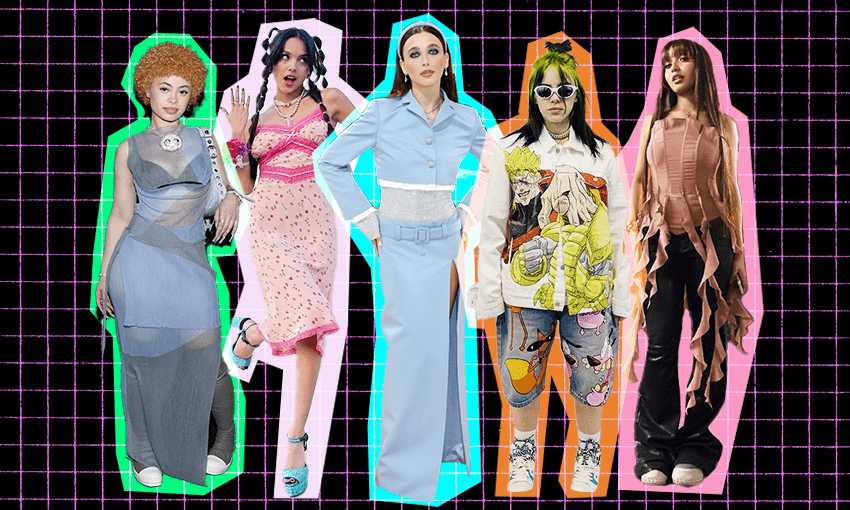Looking cool now is all about experimenting with clothes and being your authentic self, writes GenZer Naomii Seah.
So you want to dress like a Zoomer but don’t know how? I can’t say I blame you for being confused. To an onlooker, Gen Z’s fashion choices and aesthetic may seem like a mishmash of cultural references seemingly pulled at random. Is Bella Swan from Twilight cool again? Why would anyone voluntarily wear oversized denim shorts? And didn’t we all agree big floral chokers were ugly when Carrie Bradshaw had that phase on Sex and the City (1998)?
The clothes we wear represent many things including culture, class, gender and social values. Fashion doesn’t just reflect what designers like the look of that year, but also the zeitgeist itself: our anxieties, our hopes and dreams.
Each generation creates a distinct style. In the 50s, Dior’s new look signalled a turn toward materialism and the optimism of the post-war boom. In the early 60s, miniskirts and new materials reflected the progressive mood sweeping through society. Then, later in the decade, the civil rights movement and a growing interest in environmentalism brought in natural hair and looser, craft-inspired clothing – a trend that lasted well into the 70s.
In each decade, fashion held a mirror to the defining issues of the time. Now, Generation Z – those between 12 and 26 years of age – are again evolving fashion during a time of sociopolitical and cultural upheaval.
Generation Z is the first generation to grow up on the internet from birth – the first iPad kids. We’ve come of age during a pandemic, climate change and late-stage capitalism. All of this feeds into Gen Z’s relationship to fashion and the aesthetics they gravitate towards. You want to know how to dress like Generation Z? The key lies in understanding our existential dread.
Knock knock, it’s social media again…
Fashion has always operated in much the same way: what’s fashionable is decided by the elite few, and is slowly adopted by consumers. That is, until now. With the advent of the internet, fashion is seemingly becoming democratised for the first time.
What’s cool is increasingly finding its genesis online. Thanks to social media, the preoccupations of Gen Z are writ larger than ever before – and in an audiovisual format that makes the content we consume hyper-visible.
First we had trends. Now we have microtrends that last months or even mere weeks – think of the House of Sunny hockney dress, the strawberry dress, Euro summer. The trend cycle – and therefore the pressure of conformity – is becoming more evident than ever before. At the same time, the vast information of the internet means any number of aesthetic references to the past could be being made at the same time. There’s an overwhelming amount of choice.
Which is why for Gen Z, there’s a rising emphasis on personal style and individuality.
The zoomers have gone insane pic.twitter.com/3NxAuQSWgI
— 𝙒𝙪𝙡𝙛. (@aero_wulf) September 13, 2023
…and all that other stuff
Trends are prescriptive. They tell you what to wear and, often, how to wear it. The phenomenon of an item going “viral” is one that encourages overconsumption, and Gen Z knows it even though we’re guilty of perpetuating both.
According to the Business of Fashion, GenZers in the United States spend more money on fashion than on other entertainment categories like dining and gaming. Yet GenZers consistently rate sustainability as a top priority. So it makes sense that the resale market is projected to grow significantly. In lockdown, DIY styles rose in popularity, as did repurposing fabric from old clothing or “up-cycling”.
These trends not only reflect GenZ’s climate consciousness – fashion is responsible for 10% of global emissions – but their financial outlook. Gen Z is increasingly concerned about the cost of living and economic uncertainty. Second-hand clothing is both more cost-effective, and seemingly environmentally friendly (though some argue it’s becoming more akin to fast fashion).
So an emphasis on personal style and individuality isn’t just a response to being oversaturated with aesthetic choices. It’s also a reflection of climate and financial anxiety.
At the same time, the aesthetics that rise in popularity are all variations of the same worries. After all, gorpcore, cottage-core, apocalypse-core, or our obsession with “old money” and quiet luxury, are all the same sides of the environmentally and financially anxious coin. “Shopping your wardrobe”, multi-use fashion, DIY fashion, the renewed interest in sewing and fibre arts – you name a Gen Z trend, and it’s probably been marketed as environmentally friendly, money saving, or a page from that old fashion playbook: tricking other people into thinking you’re rich.
That doesn’t mean that traditional trends are going away, however. The 20-year-rule is still very much applicable given Y2K has been trending for years now. There’s now just endless ways to rehash old trends, and a vast visual library to draw from. Every single detail of every single look that existed in the 2000s can be referenced. It’s just a matter of incorporating it into your “personal style”.
Although these climate and financial anxieties dominate trend-cycles, other cultural moments are being reflected too. A growing awareness of racial inequities, gender issues and ingrained misogyny are leading to more androgynous styles and calls for diversity within the fashion industry.
In this current moment, what’s important to Gen Z is authenticity, or at least the illusion of it. In the realm of fashion, the question of what’s cool is less important than the idea that one is dressing as “authentically yourself” as possible, no matter what that means for you. The overriding spirit of experimentation – creating unique combinations that draw on diverse inspirations – is what makes Gen Z fashion unique.
So you want to dress like Gen Z? If you have your own true sense of style, you probably already are.



